Economic Contribution of International Students to Australia's Economy
VerifiedAdded on 2022/11/11
|6
|1521
|414
Report
AI Summary
This report analyzes the economic contribution of international students to the Australian economy, particularly focusing on their impact in Victoria, with a specific emphasis on Melbourne Polytechnic. The report explores the demographics of international students, their expenditure patterns, and the types of courses they enroll in. It also examines the job opportunities available to international students and the indirect benefits they bring to the economy, such as increased export earnings and cultural enrichment. The findings highlight the significant financial contributions made by international students through tuition fees, living expenses, and spending on goods and services, as well as their role in job creation and the diversification of the Australian economy. The report draws on various sources including government reports, research studies, and industry analysis to present a comprehensive overview of the economic impact of international students.
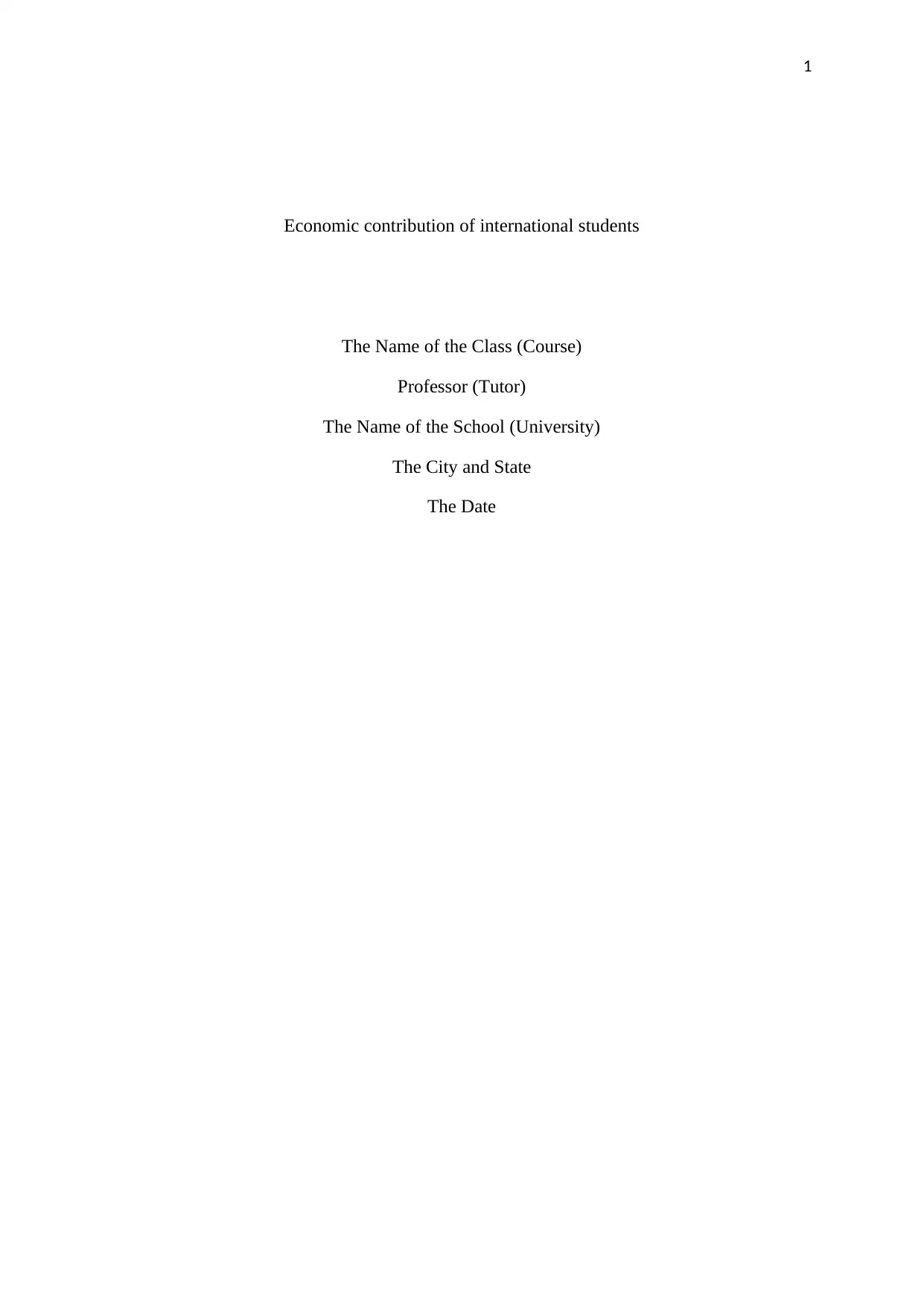
1
Economic contribution of international students
The Name of the Class (Course)
Professor (Tutor)
The Name of the School (University)
The City and State
The Date
Economic contribution of international students
The Name of the Class (Course)
Professor (Tutor)
The Name of the School (University)
The City and State
The Date
Paraphrase This Document
Need a fresh take? Get an instant paraphrase of this document with our AI Paraphraser
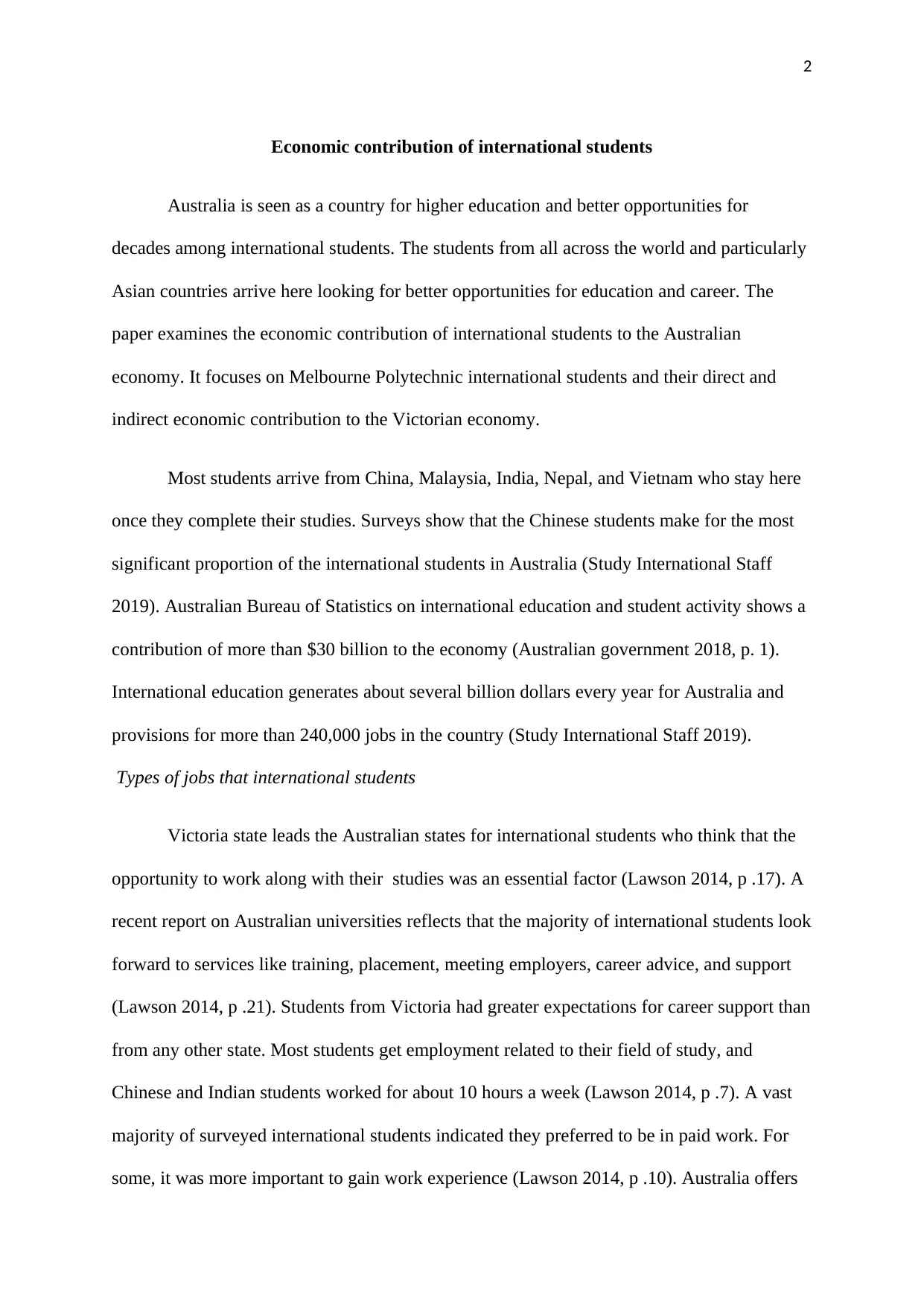
2
Economic contribution of international students
Australia is seen as a country for higher education and better opportunities for
decades among international students. The students from all across the world and particularly
Asian countries arrive here looking for better opportunities for education and career. The
paper examines the economic contribution of international students to the Australian
economy. It focuses on Melbourne Polytechnic international students and their direct and
indirect economic contribution to the Victorian economy.
Most students arrive from China, Malaysia, India, Nepal, and Vietnam who stay here
once they complete their studies. Surveys show that the Chinese students make for the most
significant proportion of the international students in Australia (Study International Staff
2019). Australian Bureau of Statistics on international education and student activity shows a
contribution of more than $30 billion to the economy (Australian government 2018, p. 1).
International education generates about several billion dollars every year for Australia and
provisions for more than 240,000 jobs in the country (Study International Staff 2019).
Types of jobs that international students
Victoria state leads the Australian states for international students who think that the
opportunity to work along with their studies was an essential factor (Lawson 2014, p .17). A
recent report on Australian universities reflects that the majority of international students look
forward to services like training, placement, meeting employers, career advice, and support
(Lawson 2014, p .21). Students from Victoria had greater expectations for career support than
from any other state. Most students get employment related to their field of study, and
Chinese and Indian students worked for about 10 hours a week (Lawson 2014, p .7). A vast
majority of surveyed international students indicated they preferred to be in paid work. For
some, it was more important to gain work experience (Lawson 2014, p .10). Australia offers
Economic contribution of international students
Australia is seen as a country for higher education and better opportunities for
decades among international students. The students from all across the world and particularly
Asian countries arrive here looking for better opportunities for education and career. The
paper examines the economic contribution of international students to the Australian
economy. It focuses on Melbourne Polytechnic international students and their direct and
indirect economic contribution to the Victorian economy.
Most students arrive from China, Malaysia, India, Nepal, and Vietnam who stay here
once they complete their studies. Surveys show that the Chinese students make for the most
significant proportion of the international students in Australia (Study International Staff
2019). Australian Bureau of Statistics on international education and student activity shows a
contribution of more than $30 billion to the economy (Australian government 2018, p. 1).
International education generates about several billion dollars every year for Australia and
provisions for more than 240,000 jobs in the country (Study International Staff 2019).
Types of jobs that international students
Victoria state leads the Australian states for international students who think that the
opportunity to work along with their studies was an essential factor (Lawson 2014, p .17). A
recent report on Australian universities reflects that the majority of international students look
forward to services like training, placement, meeting employers, career advice, and support
(Lawson 2014, p .21). Students from Victoria had greater expectations for career support than
from any other state. Most students get employment related to their field of study, and
Chinese and Indian students worked for about 10 hours a week (Lawson 2014, p .7). A vast
majority of surveyed international students indicated they preferred to be in paid work. For
some, it was more important to gain work experience (Lawson 2014, p .10). Australia offers
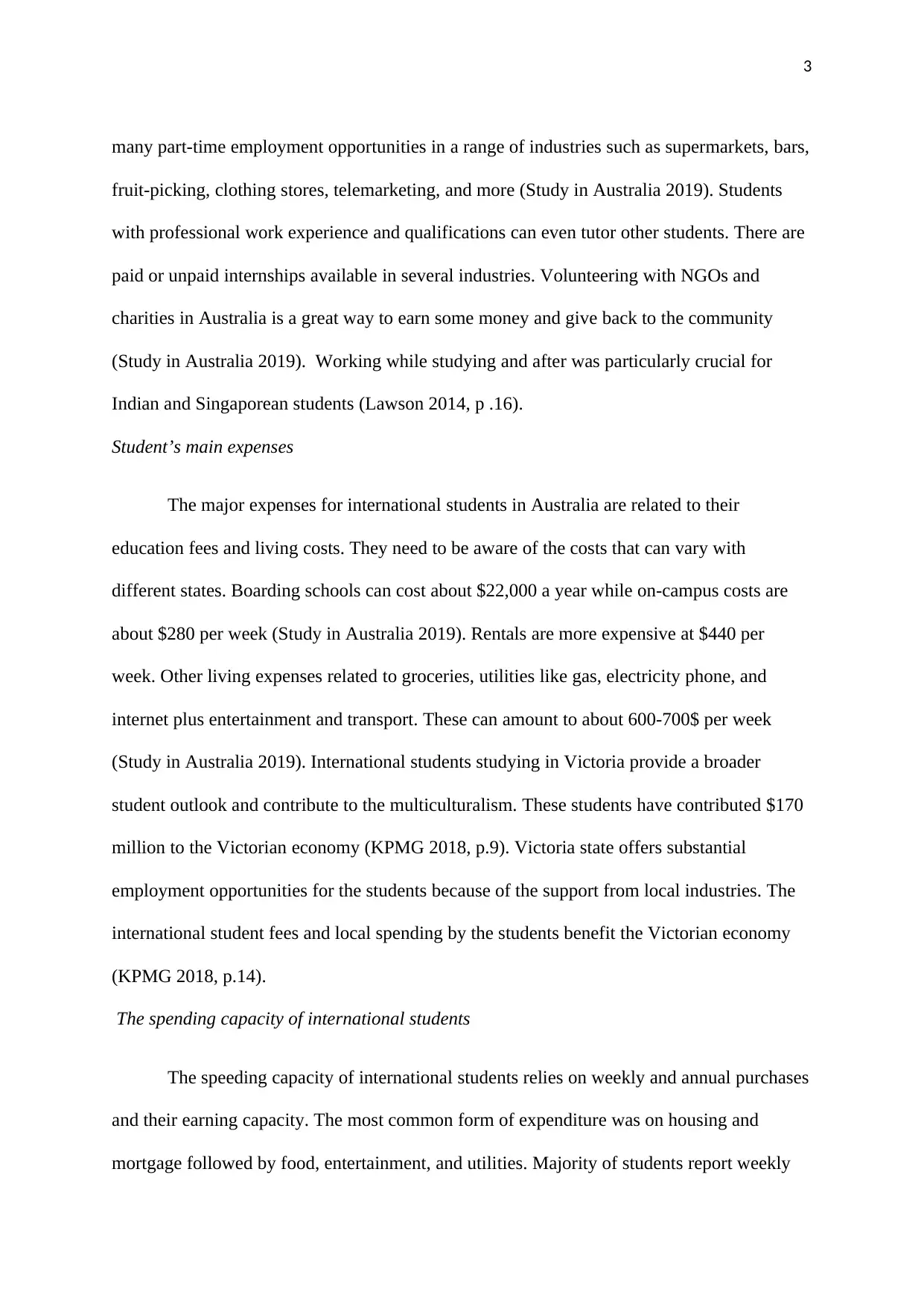
3
many part-time employment opportunities in a range of industries such as supermarkets, bars,
fruit-picking, clothing stores, telemarketing, and more (Study in Australia 2019). Students
with professional work experience and qualifications can even tutor other students. There are
paid or unpaid internships available in several industries. Volunteering with NGOs and
charities in Australia is a great way to earn some money and give back to the community
(Study in Australia 2019). Working while studying and after was particularly crucial for
Indian and Singaporean students (Lawson 2014, p .16).
Student’s main expenses
The major expenses for international students in Australia are related to their
education fees and living costs. They need to be aware of the costs that can vary with
different states. Boarding schools can cost about $22,000 a year while on-campus costs are
about $280 per week (Study in Australia 2019). Rentals are more expensive at $440 per
week. Other living expenses related to groceries, utilities like gas, electricity phone, and
internet plus entertainment and transport. These can amount to about 600-700$ per week
(Study in Australia 2019). International students studying in Victoria provide a broader
student outlook and contribute to the multiculturalism. These students have contributed $170
million to the Victorian economy (KPMG 2018, p.9). Victoria state offers substantial
employment opportunities for the students because of the support from local industries. The
international student fees and local spending by the students benefit the Victorian economy
(KPMG 2018, p.14).
The spending capacity of international students
The speeding capacity of international students relies on weekly and annual purchases
and their earning capacity. The most common form of expenditure was on housing and
mortgage followed by food, entertainment, and utilities. Majority of students report weekly
many part-time employment opportunities in a range of industries such as supermarkets, bars,
fruit-picking, clothing stores, telemarketing, and more (Study in Australia 2019). Students
with professional work experience and qualifications can even tutor other students. There are
paid or unpaid internships available in several industries. Volunteering with NGOs and
charities in Australia is a great way to earn some money and give back to the community
(Study in Australia 2019). Working while studying and after was particularly crucial for
Indian and Singaporean students (Lawson 2014, p .16).
Student’s main expenses
The major expenses for international students in Australia are related to their
education fees and living costs. They need to be aware of the costs that can vary with
different states. Boarding schools can cost about $22,000 a year while on-campus costs are
about $280 per week (Study in Australia 2019). Rentals are more expensive at $440 per
week. Other living expenses related to groceries, utilities like gas, electricity phone, and
internet plus entertainment and transport. These can amount to about 600-700$ per week
(Study in Australia 2019). International students studying in Victoria provide a broader
student outlook and contribute to the multiculturalism. These students have contributed $170
million to the Victorian economy (KPMG 2018, p.9). Victoria state offers substantial
employment opportunities for the students because of the support from local industries. The
international student fees and local spending by the students benefit the Victorian economy
(KPMG 2018, p.14).
The spending capacity of international students
The speeding capacity of international students relies on weekly and annual purchases
and their earning capacity. The most common form of expenditure was on housing and
mortgage followed by food, entertainment, and utilities. Majority of students report weekly
⊘ This is a preview!⊘
Do you want full access?
Subscribe today to unlock all pages.

Trusted by 1+ million students worldwide
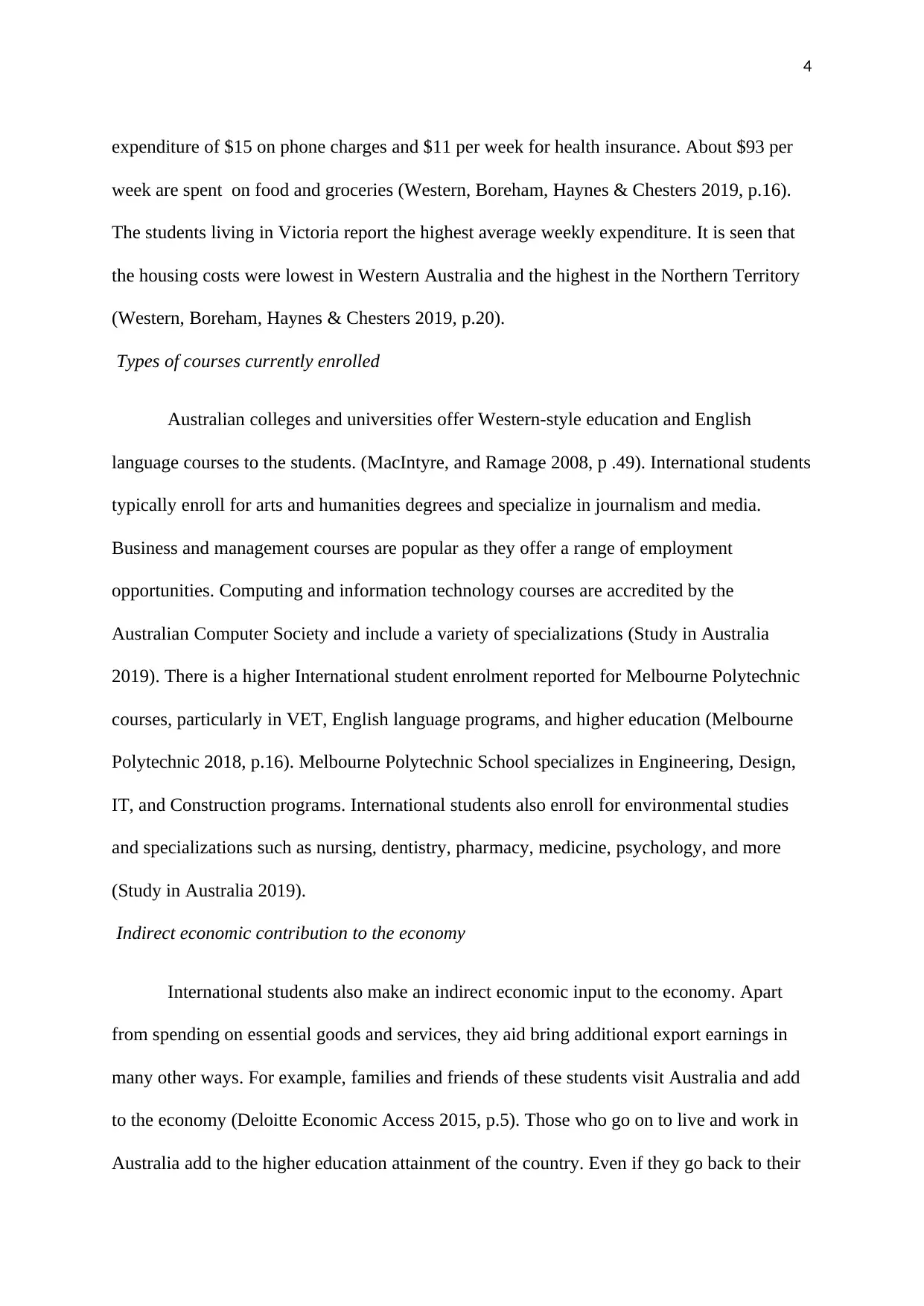
4
expenditure of $15 on phone charges and $11 per week for health insurance. About $93 per
week are spent on food and groceries (Western, Boreham, Haynes & Chesters 2019, p.16).
The students living in Victoria report the highest average weekly expenditure. It is seen that
the housing costs were lowest in Western Australia and the highest in the Northern Territory
(Western, Boreham, Haynes & Chesters 2019, p.20).
Types of courses currently enrolled
Australian colleges and universities offer Western-style education and English
language courses to the students. (MacIntyre, and Ramage 2008, p .49). International students
typically enroll for arts and humanities degrees and specialize in journalism and media.
Business and management courses are popular as they offer a range of employment
opportunities. Computing and information technology courses are accredited by the
Australian Computer Society and include a variety of specializations (Study in Australia
2019). There is a higher International student enrolment reported for Melbourne Polytechnic
courses, particularly in VET, English language programs, and higher education (Melbourne
Polytechnic 2018, p.16). Melbourne Polytechnic School specializes in Engineering, Design,
IT, and Construction programs. International students also enroll for environmental studies
and specializations such as nursing, dentistry, pharmacy, medicine, psychology, and more
(Study in Australia 2019).
Indirect economic contribution to the economy
International students also make an indirect economic input to the economy. Apart
from spending on essential goods and services, they aid bring additional export earnings in
many other ways. For example, families and friends of these students visit Australia and add
to the economy (Deloitte Economic Access 2015, p.5). Those who go on to live and work in
Australia add to the higher education attainment of the country. Even if they go back to their
expenditure of $15 on phone charges and $11 per week for health insurance. About $93 per
week are spent on food and groceries (Western, Boreham, Haynes & Chesters 2019, p.16).
The students living in Victoria report the highest average weekly expenditure. It is seen that
the housing costs were lowest in Western Australia and the highest in the Northern Territory
(Western, Boreham, Haynes & Chesters 2019, p.20).
Types of courses currently enrolled
Australian colleges and universities offer Western-style education and English
language courses to the students. (MacIntyre, and Ramage 2008, p .49). International students
typically enroll for arts and humanities degrees and specialize in journalism and media.
Business and management courses are popular as they offer a range of employment
opportunities. Computing and information technology courses are accredited by the
Australian Computer Society and include a variety of specializations (Study in Australia
2019). There is a higher International student enrolment reported for Melbourne Polytechnic
courses, particularly in VET, English language programs, and higher education (Melbourne
Polytechnic 2018, p.16). Melbourne Polytechnic School specializes in Engineering, Design,
IT, and Construction programs. International students also enroll for environmental studies
and specializations such as nursing, dentistry, pharmacy, medicine, psychology, and more
(Study in Australia 2019).
Indirect economic contribution to the economy
International students also make an indirect economic input to the economy. Apart
from spending on essential goods and services, they aid bring additional export earnings in
many other ways. For example, families and friends of these students visit Australia and add
to the economy (Deloitte Economic Access 2015, p.5). Those who go on to live and work in
Australia add to the higher education attainment of the country. Even if they go back to their
Paraphrase This Document
Need a fresh take? Get an instant paraphrase of this document with our AI Paraphraser
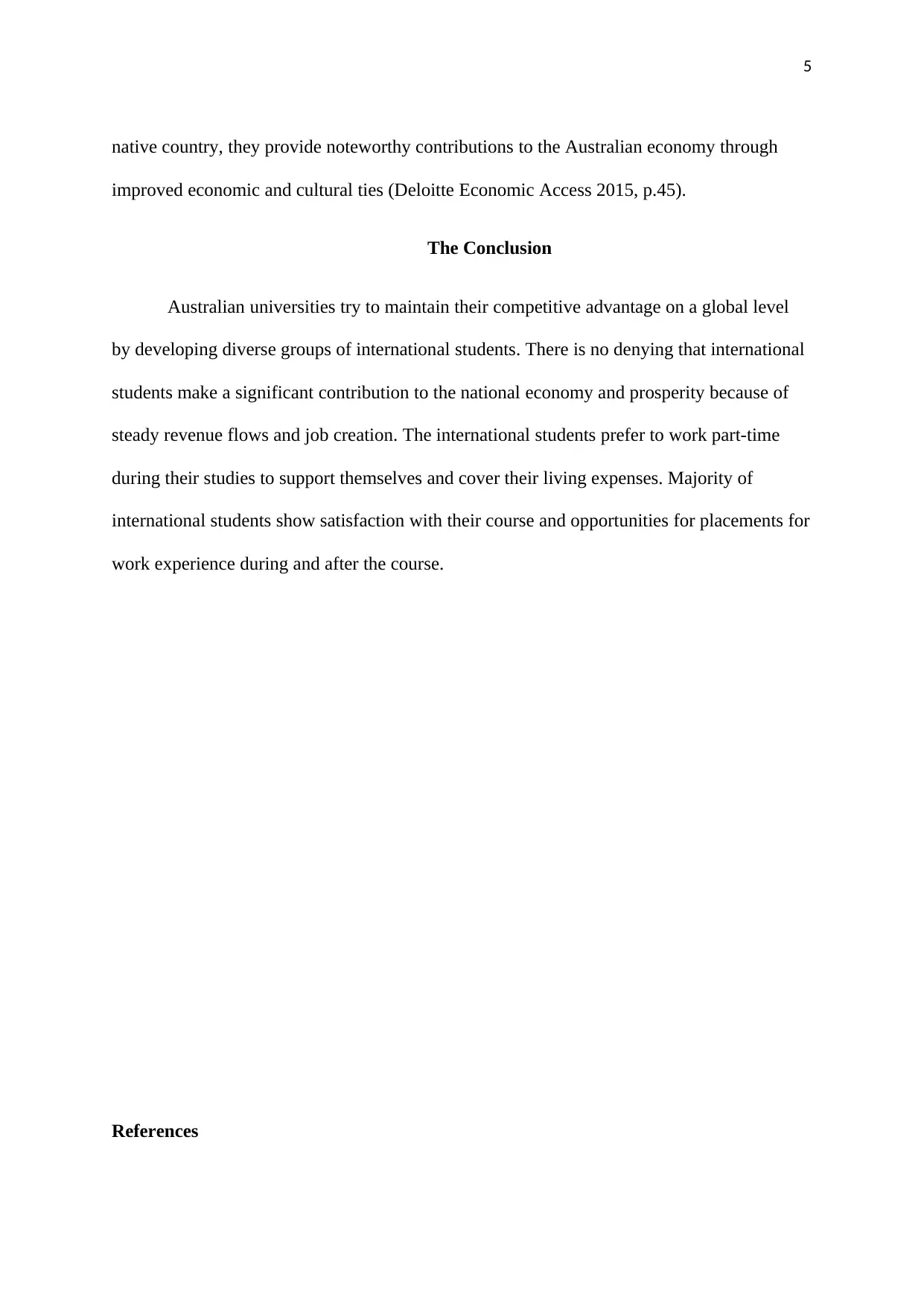
5
native country, they provide noteworthy contributions to the Australian economy through
improved economic and cultural ties (Deloitte Economic Access 2015, p.45).
The Conclusion
Australian universities try to maintain their competitive advantage on a global level
by developing diverse groups of international students. There is no denying that international
students make a significant contribution to the national economy and prosperity because of
steady revenue flows and job creation. The international students prefer to work part-time
during their studies to support themselves and cover their living expenses. Majority of
international students show satisfaction with their course and opportunities for placements for
work experience during and after the course.
References
native country, they provide noteworthy contributions to the Australian economy through
improved economic and cultural ties (Deloitte Economic Access 2015, p.45).
The Conclusion
Australian universities try to maintain their competitive advantage on a global level
by developing diverse groups of international students. There is no denying that international
students make a significant contribution to the national economy and prosperity because of
steady revenue flows and job creation. The international students prefer to work part-time
during their studies to support themselves and cover their living expenses. Majority of
international students show satisfaction with their course and opportunities for placements for
work experience during and after the course.
References
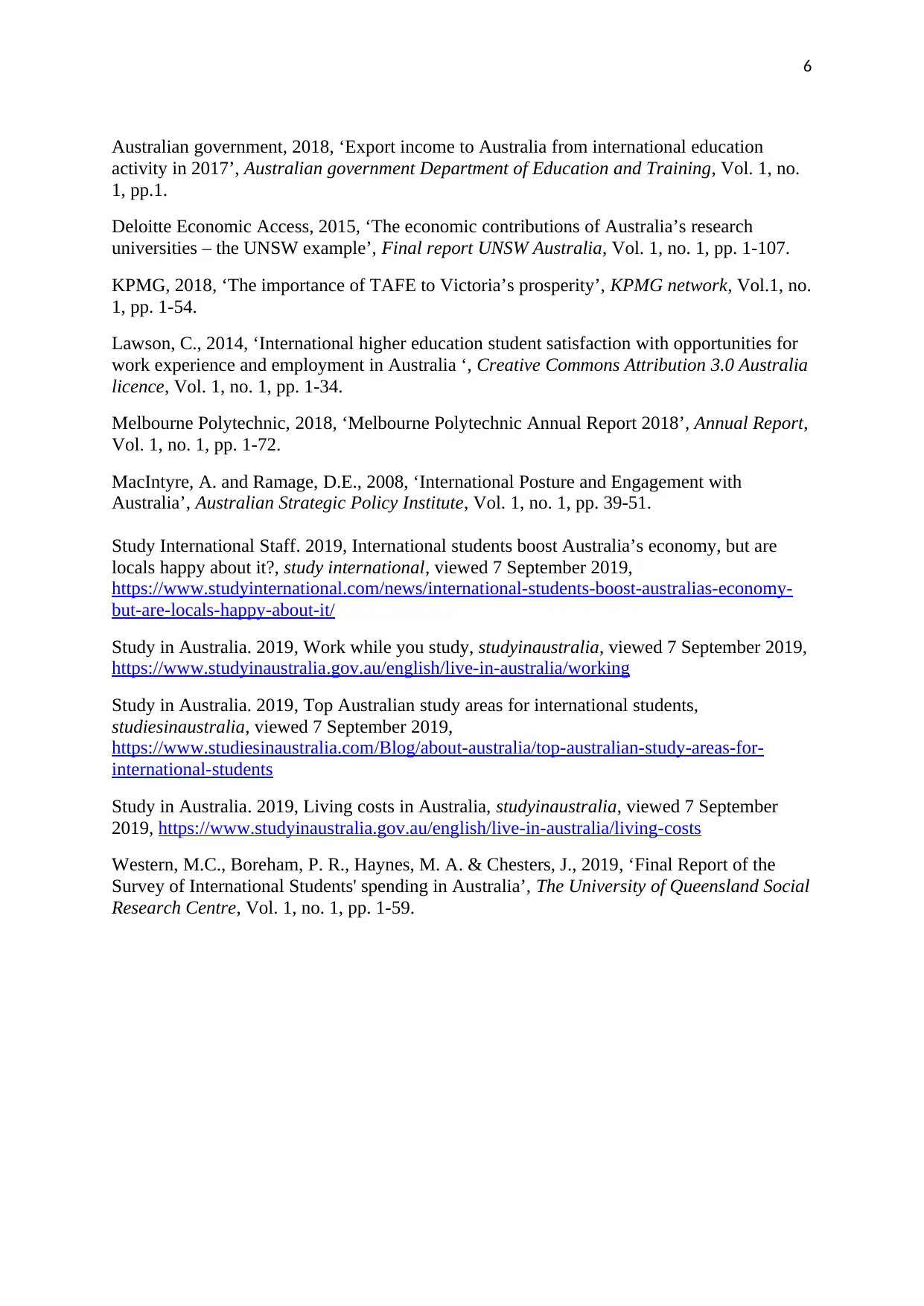
6
Australian government, 2018, ‘Export income to Australia from international education
activity in 2017’, Australian government Department of Education and Training, Vol. 1, no.
1, pp.1.
Deloitte Economic Access, 2015, ‘The economic contributions of Australia’s research
universities – the UNSW example’, Final report UNSW Australia, Vol. 1, no. 1, pp. 1-107.
KPMG, 2018, ‘The importance of TAFE to Victoria’s prosperity’, KPMG network, Vol.1, no.
1, pp. 1-54.
Lawson, C., 2014, ‘International higher education student satisfaction with opportunities for
work experience and employment in Australia ‘, Creative Commons Attribution 3.0 Australia
licence, Vol. 1, no. 1, pp. 1-34.
Melbourne Polytechnic, 2018, ‘Melbourne Polytechnic Annual Report 2018’, Annual Report,
Vol. 1, no. 1, pp. 1-72.
MacIntyre, A. and Ramage, D.E., 2008, ‘International Posture and Engagement with
Australia’, Australian Strategic Policy Institute, Vol. 1, no. 1, pp. 39-51.
Study International Staff. 2019, International students boost Australia’s economy, but are
locals happy about it?, study international, viewed 7 September 2019,
https://www.studyinternational.com/news/international-students-boost-australias-economy-
but-are-locals-happy-about-it/
Study in Australia. 2019, Work while you study, studyinaustralia, viewed 7 September 2019,
https://www.studyinaustralia.gov.au/english/live-in-australia/working
Study in Australia. 2019, Top Australian study areas for international students,
studiesinaustralia, viewed 7 September 2019,
https://www.studiesinaustralia.com/Blog/about-australia/top-australian-study-areas-for-
international-students
Study in Australia. 2019, Living costs in Australia, studyinaustralia, viewed 7 September
2019, https://www.studyinaustralia.gov.au/english/live-in-australia/living-costs
Western, M.C., Boreham, P. R., Haynes, M. A. & Chesters, J., 2019, ‘Final Report of the
Survey of International Students' spending in Australia’, The University of Queensland Social
Research Centre, Vol. 1, no. 1, pp. 1-59.
Australian government, 2018, ‘Export income to Australia from international education
activity in 2017’, Australian government Department of Education and Training, Vol. 1, no.
1, pp.1.
Deloitte Economic Access, 2015, ‘The economic contributions of Australia’s research
universities – the UNSW example’, Final report UNSW Australia, Vol. 1, no. 1, pp. 1-107.
KPMG, 2018, ‘The importance of TAFE to Victoria’s prosperity’, KPMG network, Vol.1, no.
1, pp. 1-54.
Lawson, C., 2014, ‘International higher education student satisfaction with opportunities for
work experience and employment in Australia ‘, Creative Commons Attribution 3.0 Australia
licence, Vol. 1, no. 1, pp. 1-34.
Melbourne Polytechnic, 2018, ‘Melbourne Polytechnic Annual Report 2018’, Annual Report,
Vol. 1, no. 1, pp. 1-72.
MacIntyre, A. and Ramage, D.E., 2008, ‘International Posture and Engagement with
Australia’, Australian Strategic Policy Institute, Vol. 1, no. 1, pp. 39-51.
Study International Staff. 2019, International students boost Australia’s economy, but are
locals happy about it?, study international, viewed 7 September 2019,
https://www.studyinternational.com/news/international-students-boost-australias-economy-
but-are-locals-happy-about-it/
Study in Australia. 2019, Work while you study, studyinaustralia, viewed 7 September 2019,
https://www.studyinaustralia.gov.au/english/live-in-australia/working
Study in Australia. 2019, Top Australian study areas for international students,
studiesinaustralia, viewed 7 September 2019,
https://www.studiesinaustralia.com/Blog/about-australia/top-australian-study-areas-for-
international-students
Study in Australia. 2019, Living costs in Australia, studyinaustralia, viewed 7 September
2019, https://www.studyinaustralia.gov.au/english/live-in-australia/living-costs
Western, M.C., Boreham, P. R., Haynes, M. A. & Chesters, J., 2019, ‘Final Report of the
Survey of International Students' spending in Australia’, The University of Queensland Social
Research Centre, Vol. 1, no. 1, pp. 1-59.
⊘ This is a preview!⊘
Do you want full access?
Subscribe today to unlock all pages.

Trusted by 1+ million students worldwide
1 out of 6
Related Documents
Your All-in-One AI-Powered Toolkit for Academic Success.
+13062052269
info@desklib.com
Available 24*7 on WhatsApp / Email
![[object Object]](/_next/static/media/star-bottom.7253800d.svg)
Unlock your academic potential
Copyright © 2020–2025 A2Z Services. All Rights Reserved. Developed and managed by ZUCOL.





